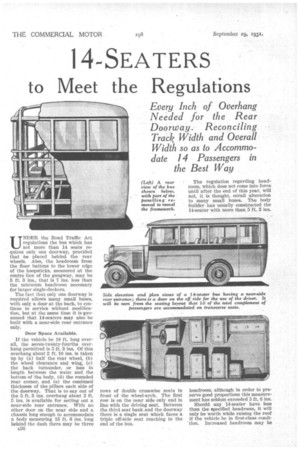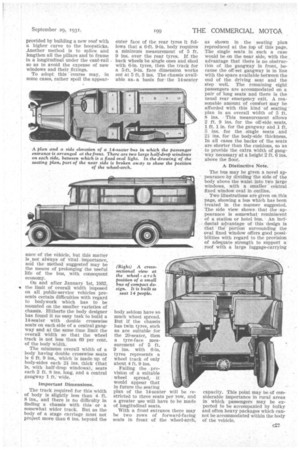14-SEATERS
Page 48

Page 49

If you've noticed an error in this article please click here to report it so we can fix it.
to Meet the Regulations
Every Inch of Overhang Needed for the Rear Doorway. Reconciling Track Width and Overall Width so as to Accommodate 14 Passengers in the Best Way
UNDER the Road Traffic Act regulations the bus which has not more than 14 seats requires otil.eone doorway, provided that he placed behind the rear wheels. Also, the headroom from the floor battens to the lower edge of the hoopsticks, measured at the centre line of the gangway, may be 5 ft. 3 ins., that is 7 ins. less than the minimum headroom necessary for larger single-cleckens.
The fact that only one doorway is required allows many small buses, with only a door at the back, to continue in service without modification, but at the same time it is presumed that 14-seaters may also be built with a near-side rear entrance only.
Door Space Available.
If the vehicle be 18 ft. long overall, the seven-twenty-fourths overhang permitted is 5 ft. 3 ins. Of this overhang about 2 ft. 10 ins, is taken up by (a) half the rear wheel, (b) the wheel clearance and wing, (c) the back turnunder, or loss in length between the waist and the bottom of the body, (d) the rounded rear corner, and (e) the combined thickness of the pillars each side of the doorway. That is to say out of the 5 ft. 3 ins, overhang about 2 ft. 5 ins, is available for setting out a near-side rear entrance. With no other door on the near side and a chassis long enough to accommodate a body measuring 13 ft. 6 ins, long behind the dash there may be three c26 rows of double crosswise seats in front of the wheel-arch. The first row is on the near side only and in line with the driving seat. Between the third seat bank and the doorway there is a single seat which faces a triple off-side seat reaching to the end of the bus.
The regulation regarding headroom, which does not come into force until after the end of this year, will not, it is thought, entail alteration to many small buses. The body builder has usually constructed the 14-seater with more than 5 ft, 3 iris.
headroom, although in order to preserve good proportions this measurement has seldom exceeded 5 ft. 6 ins.
Should any 14-seater have less than the specified headroom, it will only be worth while raising the roof if the vehicle be in first-class condition. Increased headroom may be provided by building a new roof with a higher curve to the hoopsticks. Another method is to splice and lengthen all the pillars and tO frame in a longitudinal under the cant-rail so as to avoid the expense of new windows and their. fittings.
To adopt this Course may, in some cases, rather spoil the appear mice of the vehicle, but this matter is not always of vital_ importance, and the method suggested may be the means of prolonging' the useful life of the bus, with consequent economy.
On and after, January 1st, 1932, lb the limit of overall width imposed on all public-service vehicles presents certain difficulties with regard to bodywork which has to be mounted on the smaller varieties of chassis. Hitherto the body designer has found it no easy task to build a 14-seater with double crosswise seats on each side of a central gangway and at the same time limit the overall width so that the wheel track is not less than 69 per cent. of the body width.
The minimum overall width of a • body having double crosswise seats is 6 ft 9 ins., which is made up of body-sides each 21. ins. thick (that iS, with half-drop windows), seats each 2 ft. 8 ins, long, and a central gangway 1 ft. wide.
Important Dimensions.
The track required for this width of body is slightly less than 4 ft. 8 ins., and there is no difficulty in finding a chassis with this or a somewhat wider track. But as the body of a stage carriage must not project more than 6 ins, beyond the
outer face of the rear tyres it follows that a 6-ft. 9-in, body requires a minimum measurement of 5 ft. 9 ins, over the rear tyres. If the back wheels be single ones and shod with 6-in. tyres, then the track for a 5-ft. 9-in, face dimension works out at 5 ft. 3 ins. The chassis available asa basis for the 14-seater
body seldom have so much wheel spread. But if the chassis has twin tyres, such as are suitable for the 20-seater, then a tyre-face measurement of •5 ft. 9 ins. with 6-in. tyres represents a wheel track of only about 4 ft. 9 ins.
• Failing the provision of a suitable wheel spread,it would appear that in future the seating plan of the 14-seater will be restricted to three seats per row, and a greater use will have to be made of longitudinal seats.
With a front entrance there may he two rows of forward-facing seats in front of the wheel-arch, as shown in the seating plan reproduced at the top of this page. The single seats in such a case would be on the near side, with the advantage that there is no obstruction of the gangway in front, because the off-set gangway is in line with the space available between the end of the driving seat and the step well. The remaining eight passengers are accommodated on a pair of long seats and there is the usual rear emergency exit. A reasonable amount of comfort may be afforded with this kind of seating plan in an overall width of 5 ft. 8 ins. This measurement allows 2 ft. 9 ins, for the off-side seats, 1 ft. 1 in. for the gangway and 1 ft. 5 ins, for the single seats and 24, ins, for the body-side thickness. In all cases the backs. of the seats are shorter than the cushions, so as to provide the extra width of gangway necessary at a height 2 ft. 6 ins. above the floor.
ADistinctive Note.
The bus may be given a novel appearance-by dividing the side of the body above the waist into two large windows, with a smaller central fixed window oval in outline.
Two illustrations are given on this page, showing a bus which has been treated in the manner suggested. The side view shows that -the appearance is somewhat reminiscent of a station or hotel bus. An incidental advantage of this "design is that the Portion surrounding the oval fixed window offers good possibilities with regard to the provision of adequate strength to support a roof with a large luggage-carrying capacity. This point may be of considerable importance in rural areas in which passengers may be expected to be accompanied by bulky and often heavy packages which cannot be accommodated within the body of the vehicle.












































































































